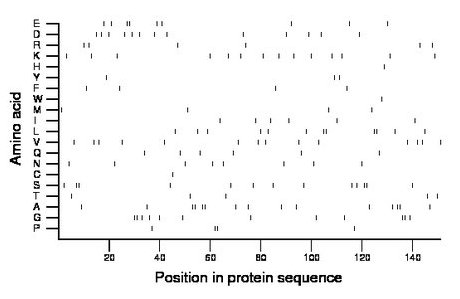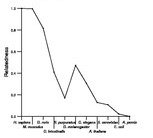
| Name: ARPC5 | Sequence: fasta or formatted (151aa) | NCBI GI: 5031593 | |
|
Description: actin related protein 2/3 complex subunit 5
|
Referenced in:
| ||
|
Composition:

Amino acid Percentage Count Longest homopolymer A alanine 9.9 15 2 C cysteine 0.7 1 1 D aspartate 8.6 13 1 E glutamate 6.0 9 2 F phenylalanine 2.6 4 1 G glycine 7.9 12 2 H histidine 0.7 1 1 I isoleucine 4.0 6 1 K lysine 9.3 14 1 L leucine 7.9 12 2 M methionine 2.6 4 1 N asparagine 5.3 8 1 P proline 2.6 4 2 Q glutamine 4.0 6 1 R arginine 4.0 6 1 S serine 8.6 13 2 T threonine 3.3 5 1 V valine 9.3 14 1 W tryptophan 0.7 1 1 Y tyrosine 2.0 3 1 |
Comparative genomics:
Search single species RefSeq proteins at NCBI
Search summary 
Figure data | ||
Related human proteins:Protein Relative score Description Self-match 1.000 actin related protein 2/3 complex subunit 5 ARPC5L 0.686 actin related protein 2/3 complex, subunit 5-like [H... ZBTB45 0.026 zinc finger and BTB domain containing 45 ATAD2 0.022 ATPase family, AAA domain containing 2 LOC646817 0.018 PREDICTED: similar to SET translocation LOC646817 0.018 PREDICTED: similar to SET translocation LOC646817 0.018 PREDICTED: similar to SET translocation TRIM55 0.011 tripartite motif-containing 55 isoform 3 TRIM55 0.011 tripartite motif-containing 55 isoform 1 TRIM55 0.011 tripartite motif-containing 55 isoform 2 MLL3 0.011 myeloid/lymphoid or mixed-lineage leukemia 3 BAT2 0.011 HLA-B associated transcript-2 HEATR6 0.011 HEAT repeat containing 6 ZFHX3 0.007 AT-binding transcription factor 1 METTL5 0.007 methyltransferase like 5 FEZ1 0.007 zygin 1 isoform 1Human BLASTP results (used to prepare the table) | |||
Gene descriptions are from NCBI RefSeq. Search results were obtained with NCBI BLAST and RefSeq entries. When identical proteins are present, the self-match may not be listed first in BLASTP output. In such cases, the table above has been reordered to place it first.
See About the Figures for the scoring system used in the figure above right. The same scoring system was used in the table of BLASTP results.
Guide to the Human Genome
Copyright © 2010 by Stewart Scherer. All rights reserved.
